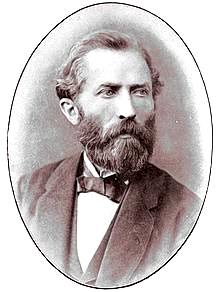
Heinrich Anton de Bary was a German surgeon, botanist, microbiologist, and mycologist . He is considered a founding father of plant pathology (phytopathology) as well as the founder of modern mycology. His extensive and careful studies of the life history of fungi and contribution to the understanding of algae and higher plants established landmarks in biology.

Antirrhinum is a genus of plants commonly known as dragon flowers or snapdragons because of the flowers' fancied resemblance to the face of a dragon that opens and closes its mouth when laterally squeezed. They are also sometimes called toadflax or dog flower. They are native to rocky areas of Europe, the United States, Canada, and North Africa. Antirrhinum species are widely used as ornamental plants in borders and as cut flowers.

Downy mildew refers to any of several types of oomycete microbes that are obligate parasites of plants. Downy mildews exclusively belong to the Peronosporaceae family. In commercial agriculture, they are a particular problem for growers of crucifers, grapes and vegetables that grow on vines. The prime example is Peronospora farinosa featured in NCBI-Taxonomy and HYP3. This pathogen does not produce survival structures in the northern states of the United States, and overwinters as live mildew colonies in Gulf Coast states. It progresses northward with cucurbit production each spring. Yield loss associated with downy mildew is most likely related to soft rots that occur after plant canopies collapse and sunburn occurs on fruit. Cucurbit downy mildew only affects leaves of cucurbit plants.

Linaria vulgaris, the common toadflax, yellow toadflax or butter-and-eggs, is a species of flowering plant in the family Plantaginaceae, native to Europe, Siberia and Central Asia. It has also been introduced and is now common in North America.
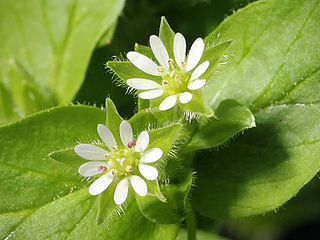
Stellaria media, chickweed, is an annual flowering plant in the family Caryophyllaceae. It is native to Eurasia and naturalized throughout the world, where it is a weed of waste ground, farmland and gardens. It is sometimes grown as a salad crop or for poultry consumption.

Antirrhinum majus, the common snapdragon, is a species of flowering plant belonging to the genus Antirrhinum. The plant was placed in the family Plantaginaceae following a revision of its prior classical family, Scrophulariaceae.
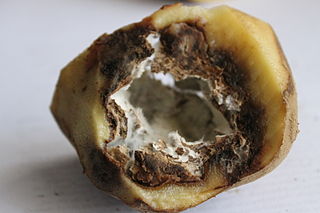
Peronosporaceae are a family of water moulds that contains 21 genera, comprising more than 600 species. Most of them are called downy mildews.
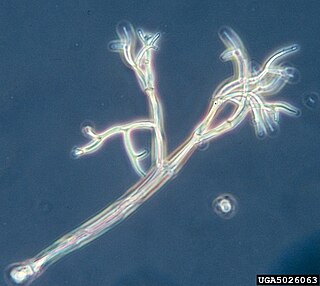
Peronospora sparsa is an oomycete plant pathogen that causes downy mildew in berry producing plants; especially in the genus's Rubus and Rosa. Downy mildew plant pathogens are often host specific and cause problems in cloudberries, blackberries, boysenberries, strawberries, and arctic bramble. Since they are host specific, Peronospora sparsa will not cause downy mildew in grapes because a different plant pathogen causes downy mildew in grapes; Plasmopara viticola. Although it depends on the cultivar, symptoms do not normally start until later stages of disease and can look different on different plants. The most common symptoms include red lesions in the veins of leaves, with dry and deformed berries.
Peronospora trifoliorum, commonly known as downy mildew of alfalfa, is an oomycete plant pathogen infecting alfalfa.
Peronospora dianthicola is a plant pathogen. It causes downy mildew on leaves of carnation. The disease is of minor importance, whether in commercial production or gardens. If necessary, it can be controlled by foliar sprays of fungicides.

Peronospora farinosa is a species name that has been widely applied to downy mildew on leaves of wild and cultivated Amaranthaceae: Amaranthus, Atriplex, Bassia, Beta, Chenopodium, Halimione, Salsola, Spinacia, etc. However, the species name has been taxonomically rejected as the original description contained reference to multiple species and could not unequivocally be attributed to a species of Peronospora. In the past, some of the species on important crop plants have been given names as formae speciales, notably f.sp. betae on sugar beet and f.sp. spinaciae on spinach. However, phylogentic reconstructions have revealed that these "forms" of Peronospora on different genera and their subdivisions, are distinct species, most of which already have previously published scientific names. Such host specialization possibly also exists with respect to the various wild amaranthaceous species given as hosts of P. farinosa.

Peronospora manshurica is a plant pathogen. It is a widespread disease on the leaves of soybeans and other crop plants. The fungi is commonly referred to as downy mildew, "leafspot", or "leaf-spot".
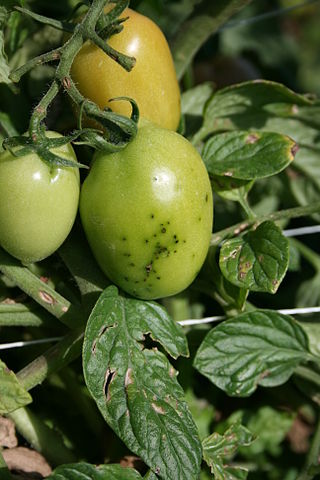
"Pseudomonas tomato" is a Gram-negative plant pathogenic bacterium that infects a variety of plants. It was once considered a pathovar of Pseudomonas syringae, but following DNA-relatedness studies, it was recognized as a separate species and several other former P. syringae pathovars were incorporated into it. Since no official name has yet been given, it is referred to by the epithet 'Pseudomonas tomato' .

Veronica polita, or grey field-speedwell, is a herbaceous flowering plant species in the plantain family Plantaginaceae. It has hairy stems, is either prostrate or ascending, with dull green leaves that are one of petiolate, serrate, ovate (rounded) and usually wider than long.The flowers are small and bright blue. The plant has solitary axillary peduncles that are shorter or slightly longer than the leaves. It is native to Eurasia, possibly including the British Isles, western Asia, northern Africa, and North America, but has been introduced into suitable habitats worldwide as a weed of cultivation. It is susceptible to downy mildew disease caused by the oomycete species Peronospora agrestis.

Peronospora is a genus of oomycetes that are obligate plant pathogens of many eudicots. Most species in this group produce a downy mildew disease, which can cause severe damage to many different cultivated crops, as well as wild and ornamental plants. There are 19 genera that produce downy mildew, and Peronospora has been placed alongside Pseudoperonospora in the group of downy mildews with coloured conidia. Peronospora has far more species than any other genus of the downy mildews. However, many species have been moved from this genus to be reclassified to other or new genera. Among these was the most famous Peronospora species, formerly known as Peronospora parasitica, and now known as Hyaloperonospora parasitica. Now, the Peronospora species of most importance is likely the Peronospora tabacina. Peronospora tabacina causes blue mold on tobacco plants and can severely reduce yields of this economically important crop to the point where it has been classified as a bioweapon.

Peronospora destructor is a plant pathogen. It causes downy mildew on leaves of cultivated and wild Allium. Allium cepa is most often affected, while Allium schoenoprasum (chives) and Allium porrum (leek) are only occasionally affected.
Peronospora anemones is a plant pathogen. It causes downy mildew on leaves of anemone. It occurs on various wild and garden forms of anemone, and has particular commercial importance on Anemone coronaria grown for cut flowers, for example in France and Italy.
Peronospora arborescens is a plant pathogen. It causes downy mildew on leaves of Papaver spp. It has economic importance on Papaver somniferum grown as an oilseed crop, for example in central and eastern Europe. It is controlled by sanitation, crop rotation, use of clean seed and fungicide sprays of the foliage. There are other species of Peronospora which occur on Papaver: Peronospora argemones (Gäum.), Peronospora cristata (Tranzschel), and Peronospora papaveris-pilosi (Vienn.-Bourg.).
Peronospora valerianellae is a plant pathogen. It causes downy mildew on leaves of lamb's lettuce Valerianella locusta, which is widely grown as a salad plant in several European countries. It is transmitted by seed-borne oospores, and is controlled by fungicide sprays of the foliage.

Fluopicolide is a fungicide used in agriculture to control diseases caused by oomycetes such as late blight of potato. It is classed as an acylpicolide and its chemical name is 2,6-dichloro-N-{[3-chloro-5-(trifluoromethyl)pyridin-2-yl]methyl}benzamide. The precise mode of action is not known, but it is thought to act by affecting spectrin-like proteins in the cytoskeleton of oomycetes. This mode of action differs from other available fungicides used to control oomycetes and it can inhibit the growth of strains that are resistant to phenylamides, strobilurin, dimethomorph and iprovalicarb. It has some systemic activity as it moves through the xylem towards the tips of stems, but does not get transported to the roots. It affects the motility of zoospores, the germination of cysts, the growth of the mycelium and sporulation. Bayer CropScience developed the compound and it was first released as a commercial product in 2006.












